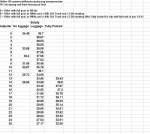I got tired of asking my wife to come out to the garage to help me measure the sag on my bike, and the subsequent "honey do's" I had to promise her everytime she did, so I decided to see if I could make a tool that I could use to do this myself.
Here is what I came up with. It's (notice correct use of apostrophe here) simply a steel bar with a hole drilled in it so the bolt for the passenger footpeg bracket can stick through it and clamp it to the bike, and then bent to put the caliper where it will hit the top of the rear drive just over the center of the axle. I then used double sided adhesive foam tape to attach my digital caliper to the bar.
All I have to do is centerstand the bike and then put the caliper on the rear drive and zero it. Then take the bike off the centerstand and put it on the sidestand and pull the caliper down so it is touching the drive, and then carefully get on the bike (without bouncing it) and sit on it and balance it. With one finger holding onto a hook attached to my garage wall, I can even put my feet on the pegs and balance the bike. Then I just carefully, and slowly get off and lean it back over on the centerstand (again, being careful not to bounce the suspension) and read the gauge. I'm able to get repeatable and accurate results and it works very well.
The photos were taken with the left bag removed so you could see the way I have it mounted, but I'm able to use it with the saddlebag in place. I also had to temporarily remove the pre-load adjuster because it was in my way when I was trying to fit the bar to the bike.


Here is what I came up with. It's (notice correct use of apostrophe here) simply a steel bar with a hole drilled in it so the bolt for the passenger footpeg bracket can stick through it and clamp it to the bike, and then bent to put the caliper where it will hit the top of the rear drive just over the center of the axle. I then used double sided adhesive foam tape to attach my digital caliper to the bar.
All I have to do is centerstand the bike and then put the caliper on the rear drive and zero it. Then take the bike off the centerstand and put it on the sidestand and pull the caliper down so it is touching the drive, and then carefully get on the bike (without bouncing it) and sit on it and balance it. With one finger holding onto a hook attached to my garage wall, I can even put my feet on the pegs and balance the bike. Then I just carefully, and slowly get off and lean it back over on the centerstand (again, being careful not to bounce the suspension) and read the gauge. I'm able to get repeatable and accurate results and it works very well.
The photos were taken with the left bag removed so you could see the way I have it mounted, but I'm able to use it with the saddlebag in place. I also had to temporarily remove the pre-load adjuster because it was in my way when I was trying to fit the bar to the bike.






